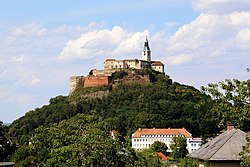You can help expand this article with text translated from the corresponding article in German. (July 2009)Click [show] for important translation instructions.
|
| Golling Castle | |
|---|---|
Burg Golling | |
| Golling an der Salzach, Salzburg, Austria | |
 View from the south | |
| Site information | |
| Type | Hill castle |
| Open to the public | Yes |
| Condition | Preserved |
 | |
| Height | 469 metres (1,539 ft) |
| Site history | |
| Built | 13th century |
| Built by | Prince-archbishops of Salzburg |
Burg Golling is a castle in Golling an der Salzach, in the Austrian state of Salzburg, erected by the Prince-Archbishops of Salzburg in the 13th century. The large fortress is located on a rock above the Salzach valley near the strategically important narrows between the Hagen and Tennen Mountains, at 469 metres (1,539 ft) above sea level. [1]







